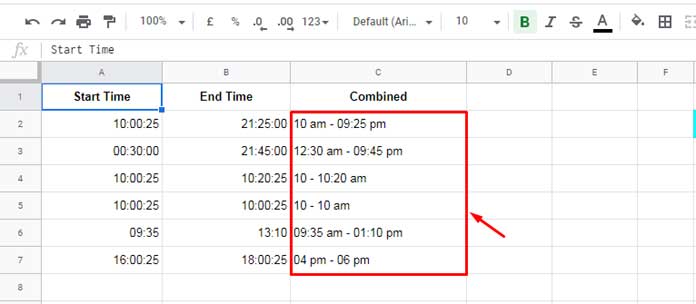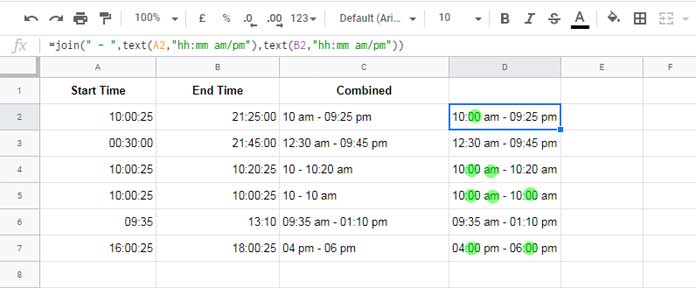Recently, I helped one of my readers concatenate a start time with an end time in his preferred format in Google Sheets.
His preferred approach was to combine a 24-hour start and end time, format it to a 12-hour format, and retain the AM/PM notation in the output.
This process also involves removing unwanted substrings—such as duplicate “AM” or “PM” notations—which I will explain later.
In this tutorial, I will show you how to properly concatenate start and end times in Google Sheets while ensuring the correct formatting.
Concatenating Two Time Cells in Google Sheets and Formatting Issues
There’s an important time formatting consideration when concatenating time values.
Normally, when you concatenate a start and end time using the ampersand (&), the output loses its time formatting.
Consider the following example:
| Start | End |
| 10:00:25 | 21:25:00 |
Using a basic formula like:
=A2&" "&B2Result: 0.416956018518519 0.892361111111111
Frustrating, right?
Using JOIN or TEXTJOIN produces a more readable result:
=JOIN(" - ", A2:B2)
=TEXTJOIN(" - ", TRUE, A2:B2)Result: 10:00:25 - 21:25:00
However, I want the result to be formatted like this:
Expected Output: 10 am - 09:25 pm
I also want to:
☑ Remove seconds.
☑ Remove minutes if they are 00.
☑ Include AM/PM notation.
☑ Avoid repeating “AM” if both times fall in the morning.
If that sounds confusing, check out rows 4 and 5 in the example below.

Concatenate Start and End Times in Google Sheets – The Right Way
To properly concatenate start and end times in Google Sheets, we can use the TEXT function.
Let’s see how we can use TEXT with JOIN and & to format the output correctly.
Using TEXT and Ampersand (&)
=TEXT(A2, "hh:mm am/pm")&" - "&TEXT(B2, "hh:mm am/pm")Using TEXT and JOIN
=JOIN(" - ", TEXT(A2, "hh:mm am/pm"), TEXT(B2, "hh:mm am/pm"))If applied in cell D2, you can drag the formula down to apply it to other rows.

Array Formula for Automatic Expansion
Instead of manually copying the formula, we can use an array formula to handle the entire column automatically:
=ArrayFormula(IF(A2:A="", "", TEXT(A2:A, "hh:mm am/pm") & " - " & TEXT(B2:B, "hh:mm am/pm")))☑ Bonus Tip: The ampersand method works with array formulas, whereas JOIN requires MAP and LAMBDA.
If you’re curious, here’s how to use MAP and LAMBDA:
=MAP(A2:A, B2:B, LAMBDA(start, end, IF(start="", "", JOIN(" - ", TEXT(start, "hh:mm am/pm"), TEXT(end, "hh:mm am/pm")))))The output in Column D is functional, but Column C has the ideal formatting. Let’s refine it further.
Removing Extra Strings After Concatenating Start and End Times in Google Sheets
Let’s refine the formatting further by:
☑ Removing :00 minutes when they exist.
☑ Avoiding duplicate AM/PM markers.
We will apply the following refinements step by step:
1. Basic Concatenation
Assume the start time is 10:00:25, and the end time is 10:20:25.
=TEXT(A2, "hh:mm am/pm") & " - " & TEXT(B2, "hh:mm am/pm")Output: 10:00 am - 10:20 am
2. Remove :00 from Minutes
Use REGEXREPLACE to eliminate unnecessary :00 values:
=TRIM(REGEXREPLACE(TEXT(A2, "hh:mm am/pm") & " - " & TEXT(B2, "hh:mm am/pm"), ":00", " "))Output: 10 am - 10:20 am
3. Avoid Repeating “AM” or “PM”
Use REGEXREPLACE to remove redundant “AM” when both times are in the same period (i.e., the first half of the day):
=TRIM(REGEXREPLACE(REGEXREPLACE(TEXT(A2, "hh:mm am/pm") & " - " & TEXT(B2, "hh:mm am/pm"), ":00", " "), "^(\d+.*) am - (\d+.*) am$", "$1 - $2 am"))Output: 10 - 10:20 am
4. Handle Empty Cells
If a cell is empty, the formula treats it as 00:00. To prevent this, wrap it in an IF statement:
=IF(A2="", "", TRIM(REGEXREPLACE(REGEXREPLACE(TEXT(A2, "hh:mm am/pm") & " - " & TEXT(B2, "hh:mm am/pm"), ":00", " "), "^(\d+.*) am - (\d+.*) am$", "$1 - $2 am")))5. Apply to an Entire Column (Array Formula)
To apply this formula across a range, modify it as an array formula:
=ArrayFormula(IF(A2:A="", "", TRIM(REGEXREPLACE(REGEXREPLACE(TEXT(A2:A, "hh:mm am/pm") & " - " & TEXT(B2:B, "hh:mm am/pm"), ":00", " "), "^(\d+.*) am - (\d+.*) am$", "$1 - $2 am"))))Now, the formula properly concatenates start and end times in Google Sheets while ensuring the correct formatting.
Related Resources
- How to Convert Military Time in Google Sheets
- Elapsed Days and Time Between Two Dates in Google Sheets
- Create a Countdown Timer Using Built-in Functions in Google Sheets
- How to Add Hours, Minutes, Seconds to Time in Google Sheets
- How to Format Time to Milliseconds in Google Sheets
- Convert Unix Timestamp to Local DateTime and Vice Versa in Google Sheets
- How to Convert Timestamp to Milliseconds in Google Sheets
- How to Extract Time from DateTime in Google Sheets: 3 Methods
- Extracting Date From Timestamp in Google Sheets: 5 Methods



















